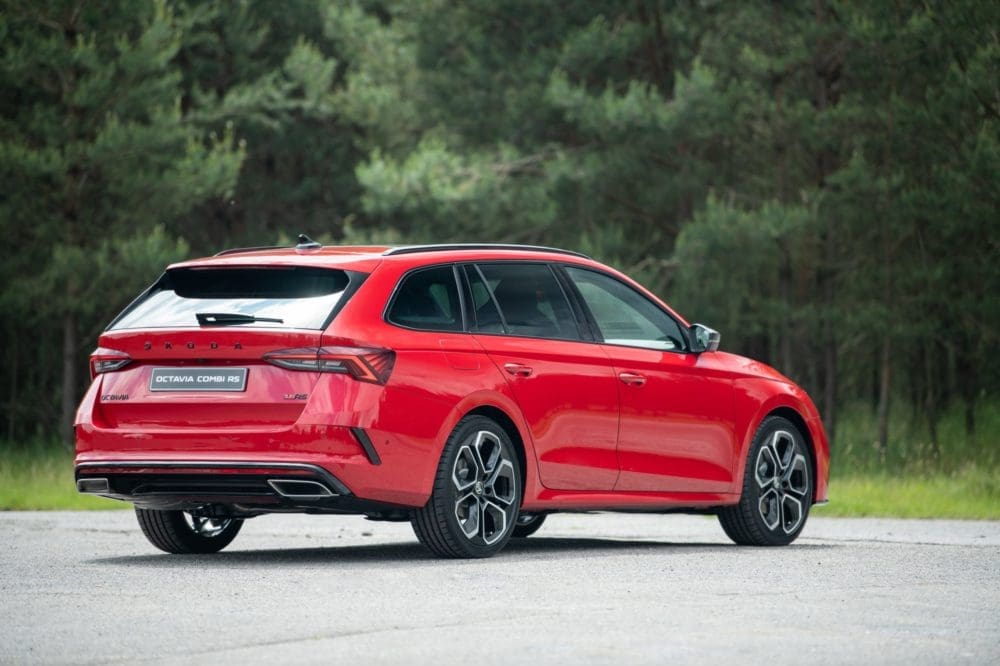



Since 2000 with the first-generation Octavia, the sportiest versions of a variety of the Czech manufacturer’s production models have borne the abbreviation ‘RS’. The letters stand for ‘Rally Sport’ and are reminiscent of the Skoda 180 RS and 200 RS rally prototypes as well as the success of the Skoda 130 RS at the Monte Carlo rally in the 1970s. Skoda built more than 17,600 units of the first Octavia vRS featuring a 1.8-litre turbo engine and generating 132 kW (178 bhp) as a hatch initially – and, as of 2002, also as an estate. More than 87,800 of the second-generation Octavia vRS rolled off the production line. In addition to a 147-kW (197 bhp) petrol engine, it was also offered for the first time with a 125-kW (168 bhp) diesel. The third-generation Octavia vRS, launched in 2013, was the first to boast the continuous red reflector strip at the rear, which has been a defining detail of vRS models ever since. It was initially available with a 162-kW (217 bhp) petrol engine, and later also with 169-kW (227bhp) and 180-kW (242bhp) petrol engines. The 2.0 TDI had an output of 135 kW (181 bhp) and offered all‑wheel drive as an option for the first time in an vRS. A total of more than 172,000 vehicles were produced. In Germany, the United Kingdom and Switzerland, vRS variants now account for more than 20 per cent of models in the range.
A choice of three drive concepts now available
In the fourth generation of the Octavia vRS, customers can opt for one of three drive systems for the first time. With a power output of 180 kW (242bhp), the new Octavia vRS iV with plug-in hybrid drive and 6-speed DSG as well as the Octavia vRS equipped with a 2.0 TSI petrol engine and a manual 6-speed gearbox or 7-speed DSG are each on a par. The 2.0 TDI delivers 147 kW (197 bhp); it is always coupled with a 7-speed DSG, and all-wheel drive is an optional extra. The control electronics of the optional all‑wheel drive react to changing driving conditions within a fraction of a second and support the driving dynamics, for example when cornering fast. Here, the system transfers part of the driving torque to the opposite wheel when the load on the inner wheel is reduced, and maintains traction.
František Drábek, Head of the Compact Model Range at Skoda Auto, said, “No matter which drive concept you opt for as an Octavia vRS enthusiast, Skoda’s vRS models deliver exactly what you would expect: they combine the performance that has been cherished by customers for decades and supreme everyday practicality. All three drive systems are convincing with their consistent power delivery and excellent fuel consumption, and showcase the latest technology in impressive style.”
Dynamic Chassis Control with new functions
In the three range-topping models, dynamic driving characteristics are ensured by the progressive steering system (standard) and vRS-typical sports suspension, which is lowered by 15 mm for the 2.0 TSI and the 2.0 TDI. Dynamic Chassis Control is available as an option and constantly adjusts the damping, thus enabling a particularly dynamic driving style in Sport mode. In Driving Mode Select, DCC now enables parameters such as suspension, damping and steering characteristics or the operation of the DSG to be adjusted to suit individual preferences. These adjustments are made using sliders via the central touchscreen. The ground clearance of the Octavia vRS iV remains unchanged when equipped with DCC. In TSI variants, an electronic VAQ limited-slip differential provides more traction on the front axle. The two most powerful versions feature 17-inch brakes, whilst the diesel is fitted with 16-inch brakes at the front and 15-inch brakes at the rear.
© Motorworld Media 2023
Registered Office: 4 Capricorn Centre, Cranes Farm Road, Basildon, Essex. SS14 3JJ
Company Number: 8818356
Website designed by Steve Dawson